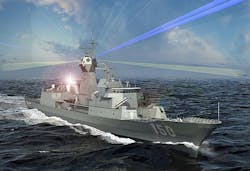Navy approaches industry for technologies available for future X-band ship self-defense radar
Officials of the Naval Surface Warfare Center Dahlgren Division in Dahlgren, Va., has issued a source-sought notice (N0017816R2002) for the X-band RF Radar project, which seeks to find relevant X-band radar technologies for potential application to future shipboard self defense.
Navy experts will use industry responses to help them formulate acquisition approaches and plans for future investments in X-band radar technologies for shipboard defense.
Navy officials are interested in radar systems and relevant subsystem technologies, including X-band active phased-array antennas and low-phase noise exciters and frequency synthesizers that are relatively mature.
The Navy is interested in X-band radar technologies that are at technology readiness level (TRL) 6 or higher. TRL 6 means technologies are ready for prototype demonstration in a realistic environment.
Navy leaders envision a new X-band active array based radar system to complement existing and emerging volume surveillance radar systems for horizon surveillance and tracking applications. They want a scalable radar design for several different kinds of surface warships.
Researchers primarily are interested in a radar system with several fixed-face arrays, they also are willing to consider single or back-to-back faces in a rotating variant.
Specifically, the Navy is looking for companies that have developed or are producing X-band active array radar systems or supporting active array antenna and low-phase noise exciter and frequency synthesizer subsystems for ship self defense. This approach could include adapting radar systems developed for land or airborne applications to the maritime environment.
White paper responses to this sources-sought notice should fall into one of two categories: X-band radar system concepts, active antenna technologies, and architectures; and X-band receiver, exciter, or frequency synthesizer technologies.
White papers addressing X-band radar system concepts, active antenna technologies, and architectures should concentrate on low-flying threats and anti-ship cruise missiles; missile illumination capability including effective radiated power and duration; missile uplink and downlink communications capability; periscope detection; surface surveillance and tracking; and dedicated tracking throughout the hemispherical coverage area from the sea surface through the zenith.
White papers addressing X-band receiver, exciter, or frequency synthesizer technologies should concentrate on tunable frequency coverage; phase noise; frequency switching speed; correlated and uncorrelated spurious signal, including harmonics; size, weight, power, and cost (SWaP-C); reliability and fault tolerance; waveform capabilities, including minimum and maximum pulse width, pulse repetition frequency, and instantaneous bandwidth; and control interfaces.
Companies interested should email 15-page white papers no later than 30 Oct. 2015 -- this Friday -- to the Navy's Kim Carter at kim.carter@navy.mil. Put X BAND RF RADAR in the subject line.
Email questions or concerns to the Navy's Kim Carter at kim.carter@navy.mil. More information is online at https://www.fbo.gov/spg/DON/NAVSEA/N00178/N0017816R2002/listing.html.

